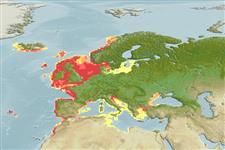Common names from other countries
Environment: milieu / climate zone / depth range / distribution range
экология
; пределы глубины 0 - 150 m (Ref. 4), usually ? - 50 m (Ref. 4). Subtropical, preferred 12°C (Ref. 107945); 69°N - 29°N, 28°W - 32°E (Ref. 4)
Eastern Atlantic, Mediterranean and Black Sea. Not in east of Crete and in the Baltic Sea.
Length at first maturity / Size / Вес / Возраст
Maturity: Lm 8.9, range 8 - 8.3 cm Max length : 65.0 cm TL самец/пол неопределен; (Ref. 441); common length : 40.0 cm TL самец/пол неопределен; (Ref. 441); наибольший вес (опубликованные данные): 6.0 kg (Ref. 4); наибольший возраст (опубликованны данные): 72 годы (Ref. 81081)
Common total length: 23 to 50 cm. Occurs on the continental shelf at depths of 0 to 150 m, usually not deeper than 50 m. Found on hard substrates such as rock or hard mud. Nocturnal and territorial living in holes or crevices. Females with eggs are usually found throughout the year. The eggs are laid around July and carried for 10 to 11 months (Ref. 4). Indiscriminate scavengers, omnivorous or carnivorous. Feeds primarily on malacostracan crustaceans, gastropod mollusks, and polychaete annelids; but diet known to include carrion, echinoderms, lamellibranchs and plant matter (Ref. 96319).
Females with eggs are usually found throughout the year. The eggs are laid around July and carried for 10 to 11 months (Ref. 4). Coupling occurs a few days after the female molts (Ref. 80921).
Основная ссылка
ссылки | координатор | соавторы
Holthuis, L.B. 1991. (Ref. 4)
Статус Красного Списка МСОП (Ref. 130435)
Статус СИТЕС (Ref. 108899)
Not Evaluated
Not Evaluated
Использование человеком
рыболовство: важный объект промысла; аквакультура (рыбоводство): экспериментальный
FAO - рыболовство: landings, Видовой профиль | FishSource | Sea Around Us
инструменты
дополнительная информация
ресурсы в Интернет
Estimates based on models
Preferred temperature
(Ref.
115969): 7.7 - 13.3, mean 10.4 (based on 494 cells).
устойчивость к внешним воздействиям
высокий, минимальное время удвоения популяции до 15 месяцев (K=0.79-1.0; Fec=13,000).
Prior r = 0.37, 95% CL = 0.25 - 0.56, Based on 1 data-limited stock assessment.
Уязвимость
Moderate to high vulnerability (46 of 100).
